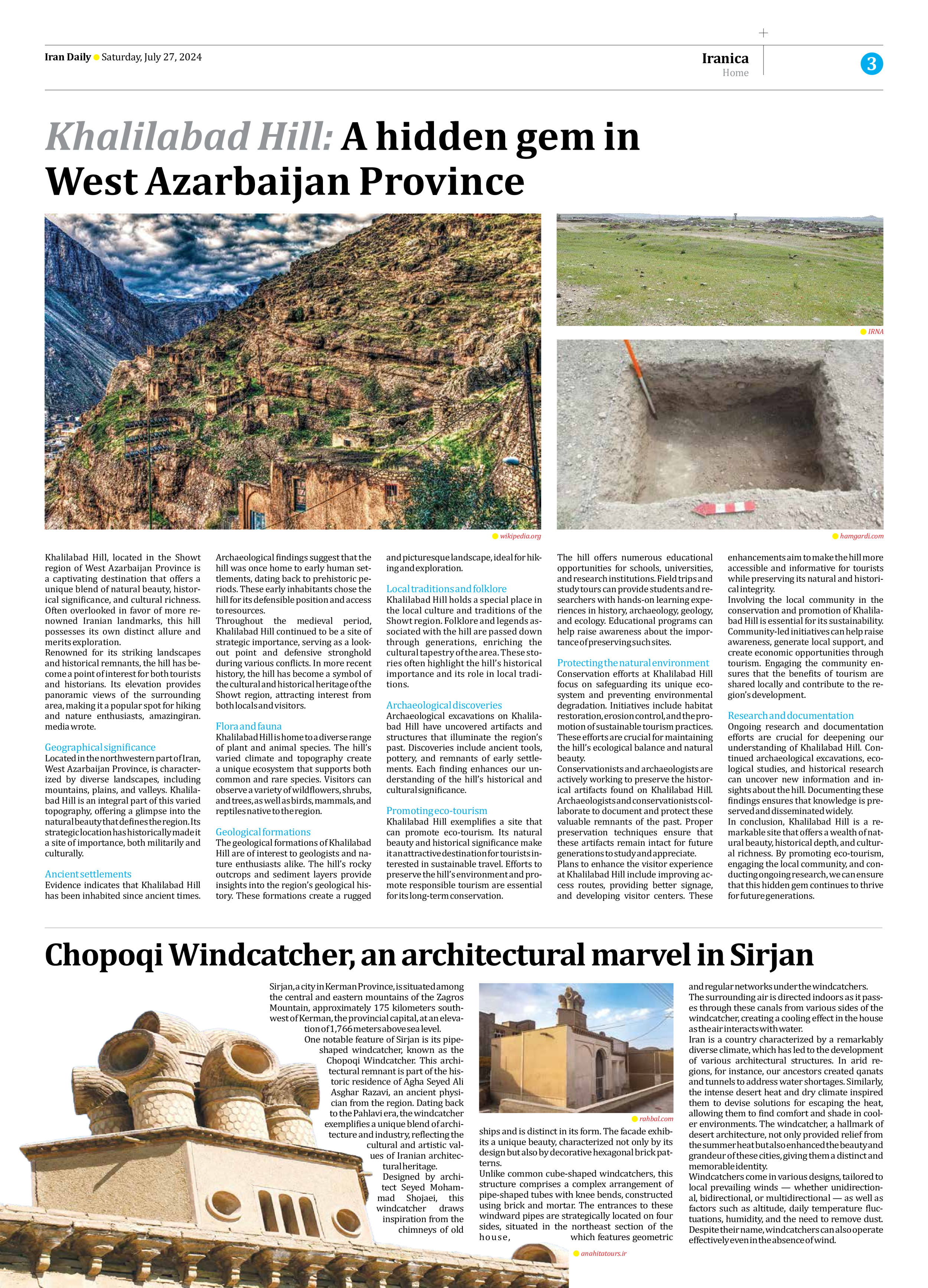
Khalilabad Hill: A hidden gem in West Azarbaijan Province
Khalilabad Hill, located in the Showt region of West Azarbaijan Province is a captivating destination that offers a unique blend of natural beauty, historical significance, and cultural richness. Often overlooked in favor of more renowned Iranian landmarks, this hill possesses its own distinct allure and merits exploration.
Renowned for its striking landscapes and historical remnants, the hill has become a point of interest for both tourists and historians. Its elevation provides panoramic views of the surrounding area, making it a popular spot for hiking and nature enthusiasts, amazingiran.media wrote.
Geographical significance
Located in the northwestern part of Iran, West Azarbaijan Province, is characterized by diverse landscapes, including mountains, plains, and valleys. Khalilabad Hill is an integral part of this varied topography, offering a glimpse into the natural beauty that defines the region. Its strategic location has historically made it a site of importance, both militarily and culturally.
Ancient settlements
Evidence indicates that Khalilabad Hill has been inhabited since ancient times. Archaeological findings suggest that the hill was once home to early human settlements, dating back to prehistoric periods. These early inhabitants chose the hill for its defensible position and access to resources.
Throughout the medieval period, Khalilabad Hill continued to be a site of strategic importance, serving as a lookout point and defensive stronghold during various conflicts. In more recent history, the hill has become a symbol of the cultural and historical heritage of the Showt region, attracting interest from both locals and visitors.
Flora and fauna
Khalilabad Hill is home to a diverse range of plant and animal species. The hill’s varied climate and topography create a unique ecosystem that supports both common and rare species. Visitors can observe a variety of wildflowers, shrubs, and trees, as well as birds, mammals, and reptiles native to the region.
Geological formations
The geological formations of Khalilabad Hill are of interest to geologists and nature enthusiasts alike. The hill’s rocky outcrops and sediment layers provide insights into the region’s geological history. These formations create a rugged and picturesque landscape, ideal for hiking and exploration.
Local traditions and folklore
Khalilabad Hill holds a special place in the local culture and traditions of the Showt region. Folklore and legends associated with the hill are passed down through generations, enriching the cultural tapestry of the area. These stories often highlight the hill’s historical importance and its role in local traditions.
Archaeological discoveries
Archaeological excavations on Khalilabad Hill have uncovered artifacts and structures that illuminate the region’s past. Discoveries include ancient tools, pottery, and remnants of early settlements. Each finding enhances our understanding of the hill’s historical and cultural significance.
Promoting eco-tourism
Khalilabad Hill exemplifies a site that can promote eco-tourism. Its natural beauty and historical significance make it an attractive destination for tourists interested in sustainable travel. Efforts to preserve the hill’s environment and promote responsible tourism are essential for its long-term conservation.
The hill offers numerous educational opportunities for schools, universities, and research institutions. Field trips and study tours can provide students and researchers with hands-on learning experiences in history, archaeology, geology, and ecology. Educational programs can help raise awareness about the importance of preserving such sites.
Protecting the natural environment
Conservation efforts at Khalilabad Hill focus on safeguarding its unique ecosystem and preventing environmental degradation. Initiatives include habitat restoration, erosion control, and the promotion of sustainable tourism practices. These efforts are crucial for maintaining the hill’s ecological balance and natural beauty.
Conservationists and archaeologists are actively working to preserve the historical artifacts found on Khalilabad Hill. Archaeologists and conservationists collaborate to document and protect these valuable remnants of the past. Proper preservation techniques ensure that these artifacts remain intact for future generations to study and appreciate.
Plans to enhance the visitor experience at Khalilabad Hill include improving access routes, providing better signage, and developing visitor centers. These enhancements aim to make the hill more accessible and informative for tourists while preserving its natural and historical integrity.
Involving the local community in the conservation and promotion of Khalilabad Hill is essential for its sustainability. Community-led initiatives can help raise awareness, generate local support, and create economic opportunities through tourism. Engaging the community ensures that the benefits of tourism are shared locally and contribute to the region’s development.
Research and documentation
Ongoing research and documentation efforts are crucial for deepening our understanding of Khalilabad Hill. Continued archaeological excavations, ecological studies, and historical research can uncover new information and insights about the hill. Documenting these findings ensures that knowledge is preserved and disseminated widely.
In conclusion, Khalilabad Hill is a remarkable site that offers a wealth of natural beauty, historical depth, and cultural richness. By promoting eco-tourism, engaging the local community, and conducting ongoing research, we can ensure that this hidden gem continues to thrive for future generations.







